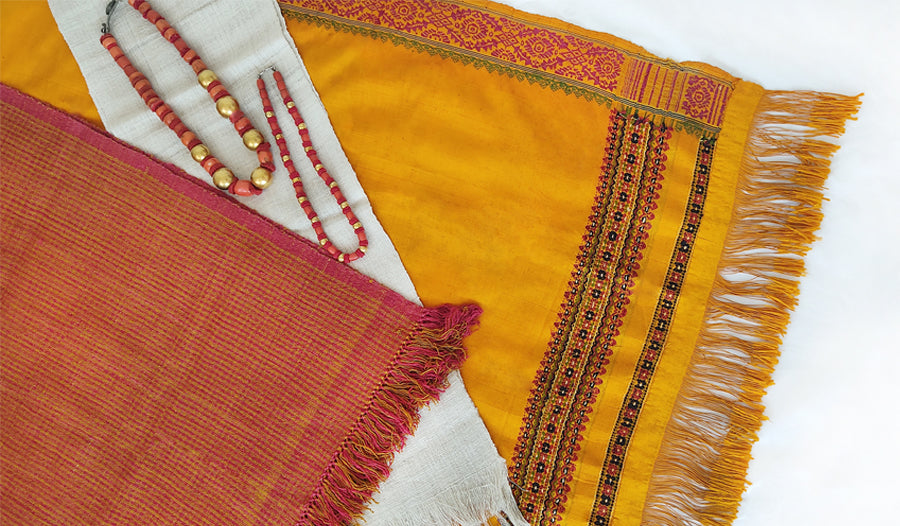
Ryndia - Eri Silk of the Khasi Hills
 Image: The traditional textiles of the Khasis - Eri Silk, Un-dyed and Plaid Ryndia used as stoles/ shawls.
Image: The traditional textiles of the Khasis - Eri Silk, Un-dyed and Plaid Ryndia used as stoles/ shawls.
Handloom weaving with unique and traditional techniques is an old-age process of the Khasis — a small ethnic group from the state of Meghalaya in North East India. Weaving Ryndia is an art passed down through the generations and treated as an occupation, providing livelihood to families in the region. Traditionally a hand-spun, hand-woven fabric, worn with pride by both the men and women in Meghalaya, the fabric in its un-dyed off-white state, or maroon and mustard plaid design, is a cultural symbol of the Khasi people. Eri silk is also known as ‘peace silk’ as the production process is considered to be non-violent.
Weaving in North-east India is primarily done by women. Eri silk in Meghalaya is produced from start to finish by women working from home or in clusters. Eri silkworms are reared by the weavers in baskets and placed throughout the homes. Mature worms are collected and put on cocooning mountages. The ready cocoons are then sundried, degummed and hand-spun using a traditional spindle.
 Image: A traditional spindle used for spinning yarn from cocoons.
Image: A traditional spindle used for spinning yarn from cocoons.
The yarns are coloured using natural dyes from plants or minerals. Traditionally the only 3 main colours used were Lac red, Turmeric yellow and Black from iron ore. Today, with training from government schemes and NGOs the artisans are able to increase their repertoire of colours. Another interesting traditional art of the region is the ‘Khneng’ embroidery. This has been practiced for around 200 years and is embroidered onto the woven Eri silk fabric. Inspired by a local insect that resembles a centipede, it is stitched entirely by hand and relies heavily on the artisans thread count to produce even sized motifs.
 Image: Khneng embroidery done on Eri silk, a languishing art.
Image: Khneng embroidery done on Eri silk, a languishing art.
Sustaining and promoting handicrafts, especially those at risk of being lost, is vital for cultural sustainability. As well as government schemes and NGOs, emerging designers and business owners can play a huge role in raising awareness and exploring design ideation for the development of the craft.
Written by Nisa Lyndem. Read more of Nisa's work on their blog.
We discuss peace silk in our article Checks & Balances: Eco Fashion's Animal Rights Debate. Read the article in Issue 98 Together.
